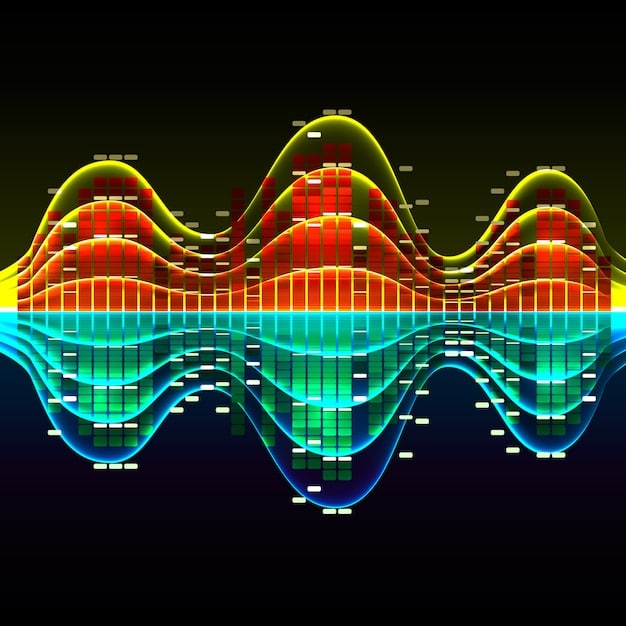Game Audio Design: Crafting Immersive Soundscapes for Games

Game audio design is the critical art and science of shaping the aural experience within interactive entertainment, meticulously crafting soundscapes that elevate immersion, convey crucial information, and evoke powerful emotions for players, directly impacting engagement and narrative conveyance.
Ever wondered what truly brings a video game world to life, beyond stunning visuals and captivating storylines? It’s often the unsung hero: the sound. Game audio design: creating immersive soundscapes for your games is not merely about adding background noise; it’s an intricate craft that transforms digital environments into believable, emotionally resonant experiences.
The Foundations of Game Audio Design
At its core, game audio design is about sculpting the player’s auditory journey. This discipline reaches far beyond simple sound effects, encompassing music, voiceovers, ambient sounds, and the programming that weaves them all together seamlessly. It’s about creating a soundscape that informs, entertains, and profoundly immerses the player, making the virtual world feel tangible and responsive.
Understanding the interplay between different audio elements is paramount. A well-designed soundscape can guide a player through complex scenarios, provide immediate feedback for actions, and even subtly influence their emotional state, enhancing the overall storytelling.
Defining the Game’s Sonic Identity
Every game possesses a unique atmosphere, and its sound should reflect this distinct personality. Establishing a sonic identity from the outset is crucial, as it sets the tone and emotional landscape players will inhabit.
- Genre Alignment: Different game genres demand unique audio approaches. A horror game requires unsettling ambient sounds and sudden stingers, while a fantasy RPG might lean on orchestral scores and nature soundscapes.
- Narrative Reinforcement: Audio works hand-in-hand with the narrative, deepening thematic elements and character arcs. A melancholic musical theme for a tragic character, or dissonant sounds during moments of tension, are examples.
- Target Audience: Considering who the game is for influences audio choices, from voice acting styles to the complexity of sound effects. Children’s games, for instance, often feature bright, exaggerated sounds.
The early stages of conceptualizing the audio for a game often involve extensive discussion with game designers, artists, and writers to ensure a cohesive vision. This collaborative approach helps create a unified experience where sound is an extension of the game’s core design principles.
Ignoring sound’s pivotal role can lead to a disjointed or unconvincing experience, no matter how strong other aspects of the game might be. A compelling sound design can elevate even a simple mechanic, transforming it into something memorable and engaging.
Crafting Immersive Soundscapes: Techniques and Tools
Achieving true immersion through sound involves a blend of artistic vision and technical mastery. It goes beyond simply recording sounds; it’s about manipulating them, spatializing them, and ensuring they react dynamically to player actions and environmental changes.
Modern game audio design leverages sophisticated techniques and powerful software to create these intricate aural worlds. Understanding these tools and methodologies is key to building compelling audio experiences that resonate deeply with players.
Key Audio Design Techniques
Dynamic audio is a cornerstone of immersion. Sounds need to adapt to the game state, player position, and in-game events. This requires careful planning and implementation.
- Positional Audio: Sounds emanate from specific points in the 3D space, allowing players to spatially locate threats or objectives by ear. This is especially vital in first-person games.
- Dynamic Mixing: Audio levels, effects, and even entirely different soundscapes shift based on gameplay. During a fierce battle, music might swell, and ambient sounds recede; in a quiet exploration phase, ambient sounds come to the forefront.
- Layering and Granularity: Complex sounds are often built from multiple layers. A single gunshot might consist of an initial crack, a body impact, and a shell casing fall, each contributing to a rich, believable effect.
Techniques like parametric audio, where sound properties respond to in-game variables, are becoming increasingly common. Imagine footsteps changing sound based on the surface material, or wind intensity increasing with altitude. These subtle details significantly enhance realism and player feedback.
Beyond technical implementation, the creative use of silence and sparse sound can be just as powerful as intricate soundscapes. Strategic silence can build tension, highlight important events, or provide moments of reflection, making subsequent sounds more impactful.

Essential Tools and Software
Professional game audio designers rely on a suite of specialized tools. These tools facilitate everything from recording and editing to integration and mixing within the game engine.
Digital Audio Workstations (DAWs) like Pro Tools, Logic Pro, and Reaper are fundamental for sound asset creation. They provide the environment for recording, editing, mixing, and mastering audio files. Beyond DAWs, various middleware solutions bridge the gap between creative audio production and game engine implementation.
- Wwise and FMOD: These are the industry-standard audio middleware solutions. They allow designers to create complex audio behaviors, manage large sound libraries, and integrate sound directly into game engines like Unity and Unreal.
- Sound Libraries and Synthesis: Access to extensive sound libraries (both commercial and self-recorded) is crucial. Additionally, sound synthesis tools enable the creation of unique sounds from scratch, offering unparalleled creative freedom.
- Spatial Audio Plugins: Plugins that simulate realistic sound propagation, occlusion, and reverberation help ground sounds within the virtual environment, adding to the feeling of presence.
Mastering these tools is as important as understanding audio theory. The ability to efficiently manage, edit, and implement sounds directly impacts the quality and flexibility of the final audio design. Furthermore, understanding basic scripting or visual scripting within these tools can greatly enhance a designer’s ability to create dynamic and interactive audio systems.
The continuous evolution of game engines and audio technology means that designers must continually update their skills and adapt to new workflows and tools. This dynamic environment pushes the boundaries of what is possible in interactive audio.
The Role of Music in Enhancing Immersion
Music in video games transcends mere background noise; it is a vital storytelling element that shapes mood, punctuates action, and provides crucial emotional context. A well-composed soundtrack can leave a lasting impression, becoming synonymous with the game itself.
The strategic deployment of musical themes, leitmotifs, and adaptive scores significantly amplifies the player’s emotional connection to the game world and its narrative. It’s a key component of what makes a game truly memorable.
Adaptive and Dynamic Music Systems
Unlike linear media, game music must respond to player actions and changing game states. This requires a dynamic, non-linear approach to composition and implementation.
- Layering: Music can be composed in layers that fade in and out based on intensity, combat, or exploration states. A quiet exploration theme might gain percussive elements as a player approaches a danger zone.
- Stingers: Short musical cues (stingers) can mark specific events, such as achieving a goal, discovering a secret, or encountering a new enemy. They provide immediate auditory feedback and satisfaction.
- Horizontal and Vertical Re-sequencing: Scores can seamlessly transition between different musical segments (horizontal) or add/remove instrumental layers (vertical) to reflect narrative shifts or gameplay intensity.
The goal of adaptive music is to create a seamless sonic flow that avoids jarring transitions. It allows the music to serve as an organic companion to the gameplay, rather than a static backdrop. This technical complexity demands close collaboration between composers and audio programmers.
Think of how music in a stealth game might become tense and sparse when an enemy is nearby, then bloom into an action theme upon detection, before settling back into a calm exploration track once the threat is neutralized. This continuous adaptation maintains immersion.
Evoking Emotion and Narrative Through Soundtracks
Music is a universal language of emotion, and in games, it speaks volumes. Composers use harmony, melody, rhythm, and instrumentation to evoke a wide range of feelings, from triumph and joy to sorrow and dread.
A distinctive main theme can become iconic, forever associated with the game. Leitmotifs, recurring musical themes assigned to characters, locations, or ideas, provide emotional depth and narrative coherence, subtly guiding the player’s understanding of the story.
- Character Themes: A heroic character might have a soaring, optimistic theme, while a villain’s theme could be dark and dissonant. These themes can evolve with the character’s journey.
- Environmental Mood Setting: Music can underscore the atmosphere of a location—a sense of peace in a vibrant forest, or oppressive dread in an abandoned facility.
- Pacing and Tension: Music manipulates the player’s perception of time and tension, speeding up during chases and slowing down during introspective moments.
The collaboration between composer and game designer is vital to ensure the music perfectly aligns with the game’s emotional arc and gameplay beats. This alignment strengthens the overall narrative impact and emotional resonance, making the player’s experience truly unforgettable.
Ultimately, a successful game soundtrack isn’t just a collection of nice songs; it’s an integral component that breathes life into the game world, enhancing every facet of the player’s journey.
Voice Acting and Dialogue: Bringing Characters to Life
Voice acting and dialogue are pivotal in establishing character personality, advancing plot, and providing essential information. Well-executed voice work can forge deep emotional connections between players and the virtual world, making characters feel more real and narratives more compelling.
It’s not just about the words spoken, but how they are spoken, including tone, emotion, and vocal nuance. The quality of voice acting can significantly impact a game’s perceived production value and overall immersion.
Casting and Directing Voice Talent
The success of in-game dialogue hinges on careful casting and effective direction. Finding the right voice to embody a character is a nuanced process that goes beyond just vocal range.
- Matching Tone and Personality: Voice actors must be able to convey the character’s intended personality, whether stoic, whimsical, menacing, or vulnerable.
- Performance Consistency: Maintaining a consistent character voice and performance across hours of dialogue is essential for believability.
- Direction for Gameplay Context: Directors must ensure lines are delivered with the correct emotion and pacing relative to specific in-game events or actions, often accounting for non-linear narrative delivery.
The role of a voice director in games is unique, as they often need to guide actors through scenes without the benefit of visual cues or traditional scene partners, relaying the specific gameplay context for each line. This ensures the voice performances are integrated seamlessly into the interactive experience.
Poor voice acting or mismatched vocalizations can easily break immersion, making characters seem wooden or unbelievable, hence the meticulous attention paid to this crucial aspect of development.
Implementing Dialogue and Localization
Once recorded, dialogue must be seamlessly integrated into the game. This involves technical implementation and often, extensive localization efforts for global audiences.
- Lip-Sync and Facial Animation: Syncing spoken dialogue with character lip movements and facial expressions is vital for visual fidelity and believability, requiring technical precision.
- Dialogue Trees and Branching Narratives: In many games, dialogue branches based on player choices, demanding complex scripting and management systems to ensure all paths are accounted for and flow logically.
- Localization Challenges: Translating dialogue for different languages involves more than direct translation; it requires cultural adaptation, voice actor casting for new languages, and ensuring the new audio fits existing animations and timing.
Localization adds significant complexity, as it involves not only translation but often re-recording lines by new actors, sometimes even changing the script to better suit cultural nuances or avoid unintended meanings. This ensures the game resonates with a diverse global audience.
Ultimately, well-designed voice acting and dialogue elevate the narrative, deepen character development, and provide a richer, more engaging experience for players by truly bringing the game’s inhabitants to life.
Technical Implementation: Bridging Creativity and Code
The most brilliant sound design concepts remain theoretical until they are technically implemented within the game engine. This critical phase involves integrating audio assets, programming their behaviors, and optimizing them for performance, bridging the gap between artistic vision and code.
Technical sound designers and audio programmers are the unsung heroes who ensure that every sound plays precisely when and how it should, reacting dynamically to the player and the game world.
Integrating Audio into Game Engines
Game engines like Unity and Unreal Engine provide frameworks for bringing audio to life. This involves importing assets, setting up audio sources, and defining their properties.
- Audio Sources and Listeners: Sounds are attached to “Audio Sources” in the game world, while the “Audio Listener” typically follows the player’s camera, determining what sounds are heard and from where.
- Mixers and Snapshots: Audio mixers allow designers to group and control the volume and effects of different sound categories (e.g., music, SFX, dialogue). “Snapshots” save specific mixer configurations that can be transitioned between for different gameplay states.
- Occlusion and Attenuation: Programming sound to realistically behave based on environmental geometry (e.g., becoming muffled behind a wall) and distance (e.g., fading as the player moves away) is crucial for realism.
Modern game engines offer sophisticated audio rendering capabilities, including advanced spatialization algorithms. Implementing these features correctly ensures that sounds are perceived directionally and realistically within the virtual environment.
The process of connecting a sound event in middleware (like Wwise) to a trigger in the game engine (like picking up an item or entering a new zone) requires careful scripting and event management.

Optimization and Performance Considerations
Audio, like graphics, consumes system resources. Efficient management and optimization are vital to ensure smooth performance without compromising sound quality.
Balancing fidelity with performance is an ongoing challenge. High-fidelity audio can be resource-intensive, particularly in games with complex soundscapes and many simultaneously playing sounds.
- Memory Management: Efficiently loading and unloading audio assets from memory to prevent crashes or slowdowns, especially for large, open-world games.
- CPU Usage: Minimizing the computational load of real-time audio processing, such as complex effects or large numbers of simultaneous voices.
- Compression and Sample Rates: Choosing appropriate compression formats and sample rates to reduce file sizes without noticeable loss in perceived quality.
Debugging audio issues, such as sounds not playing, playing incorrectly, or causing performance spikes, is a significant part of the technical sound designer’s role. This often involves profiling tools to identify bottlenecks and correct implementation errors.
Ultimately, technical implementation is about ensuring that the creative audio vision is translated into a functional, optimized, and immersive in-game experience that delights the player without taxing their system.
Testing and Iteration: Refining the Sound Experience
The journey of game audio design is inherently iterative, much like other aspects of game development. It’s rare for audio to be perfect on the first pass; continuous testing, feedback integration, and refinement are crucial for achieving a polished and impactful sound experience.
This iterative process allows designers to identify issues, experiment with new ideas, and fine-tune the soundscape until it seamlessly integrates with and elevates the gameplay.
Playtesting and Feedback Integration
Playtesting provides invaluable insights into how players actually perceive and react to the game’s audio. It’s the ultimate reality check for any sound designer.
- Identifying Immersion Breakers: Testers might notice sounds that are too loud, too quiet, out of sync, or simply don’t fit the context, disrupting their immersion.
- Clarity and Feedback: Are critical gameplay sounds (e.g., enemy footsteps, power-up acquisition, low health warnings) clear and effective in providing necessary information to the player?
- Emotional Response: Does the music evoke the intended emotions during key narrative moments or intense gameplay sequences?
Gathering feedback from diverse playtesters, including those with varying levels of audio sensitivity or equipment, helps ensure the sound design is robust and effective across a wide range of player experiences. This can involve structured surveys, direct interviews, or observing player behavior.
The feedback loop often includes internal team reviews, where developers themselves provide critical insights based on their intimate knowledge of the game’s mechanics and narrative goals.
The Iterative Refinement Cycle
Based on feedback, sound designers enter a cycle of refinement, continuously tweaking, adding, or redesigning audio elements. This cycle can include multiple passes over the same content.
- Adjusting Levels and Mixing: Rebalancing the volume of sound effects, music, and dialogue to ensure no single element overwhelms others and the overall mix is clear and dynamic.
- Re-recording or Creating New Assets: If existing sounds don’t quite fit, new audio assets may need to be recorded or synthesized from scratch to better serve the game’s needs.
- Tweaking Dynamic Behaviors: Adjusting parameters within audio middleware to ensure sounds respond optimally to in-game variables, such as distance, speed, or objective status.
This ongoing process is essential for polish. It’s about finding the optimal balance where audio isn’t just present, but actively enhances every aspect of the game, making it more intuitive, more exciting, and more emotionally resonant for the player.
The commitment to iteration is what separates good game audio from truly exceptional, immersive soundscapes that leave a lasting impact on players.
| Key Aspect | Brief Description |
|---|---|
| 🎶 Sonic Identity | Establishing a unique auditory fingerprint for the game, aligning with genre and narrative. |
| 🔊 Immersive Soundscapes | Utilizing techniques like positional audio and dynamic mixing to create realistic, responsive environments. |
| 🎼 Adaptive Music | Composing scores that dynamically adjust to gameplay and narrative shifts, enhancing emotional impact. |
| 🗣️ Voice & Dialogue | Bringing characters to life through skilled voice acting and seamless dialogue implementation. |
Frequently Asked Questions About Game Audio Design
▼
Game audio design is the comprehensive process of creating, implementing, and mixing all auditory elements in a video game. This includes sound effects, music, voice acting, and ambient sounds, with the goal of enhancing player immersion, providing critical feedback, and strengthening narrative and emotional connections to the game world. It’s a blend of art and technical craft.
▼
Game audio is crucial for immersion as it grounds players within the virtual environment, making it feel more real and reactive. Positional audio helps players navigate and identify threats by ear, while dynamic music adapts to gameplay, intensifying emotional responses. High-quality soundscapes prevent a “sterile” feeling, making the player’s presence in the game world more believable and engaging on a subconscious level.
▼
Game audio designers utilize Digital Audio Workstations (DAWs) like Pro Tools or Logic Pro for recording and editing. For integration into game engines (Unity, Unreal Engine), industry-standard audio middleware solutions like Wwise and FMOD are essential. They also employ sound libraries, synthesis tools, and spatial audio plugins to create and manage the complex auditory experiences within games.
▼
Dynamic music in games adapts in real-time to player actions and game states. This is often achieved through layering, where orchestral or instrumental parts fade in or out based on intensity (e.g., combat or exploration). It can also involve horizontal re-sequencing, where different musical segments seamlessly transition. This ensures the soundtrack always matches the current emotional and gameplay context, never feeling disjointed.
▼
Game audio localization presents several challenges beyond simple translation. It requires culturally adapting dialogue to resonate with new audiences, often involving re-writing scripts. Casting new voice actors who can match the original character’s tone is crucial. Furthermore, the newly recorded audio must be timed precisely to existing character animations and lip-syncing, demanding meticulous coordination and technical implementation to maintain quality.
Conclusion
The meticulous art and science of game audio design: creating immersive soundscapes for your games is far more than an afterthought; it is a fundamental pillar of modern interactive entertainment. From the subtle rustle of leaves to the epic swell of an orchestral score, every auditory element is carefully crafted to inform, transport, and emotionally connect players to virtual worlds. By seamlessly weaving together sound effects, music, and dialogue, audio designers elevate gameplay, deepen narrative, and transform digital experiences into unforgettable journeys. The profound impact of a well-executed soundscape ensures that a game isn’t just played, but truly felt, demonstrating that true immersion is as much about what you hear as what you see or do.





